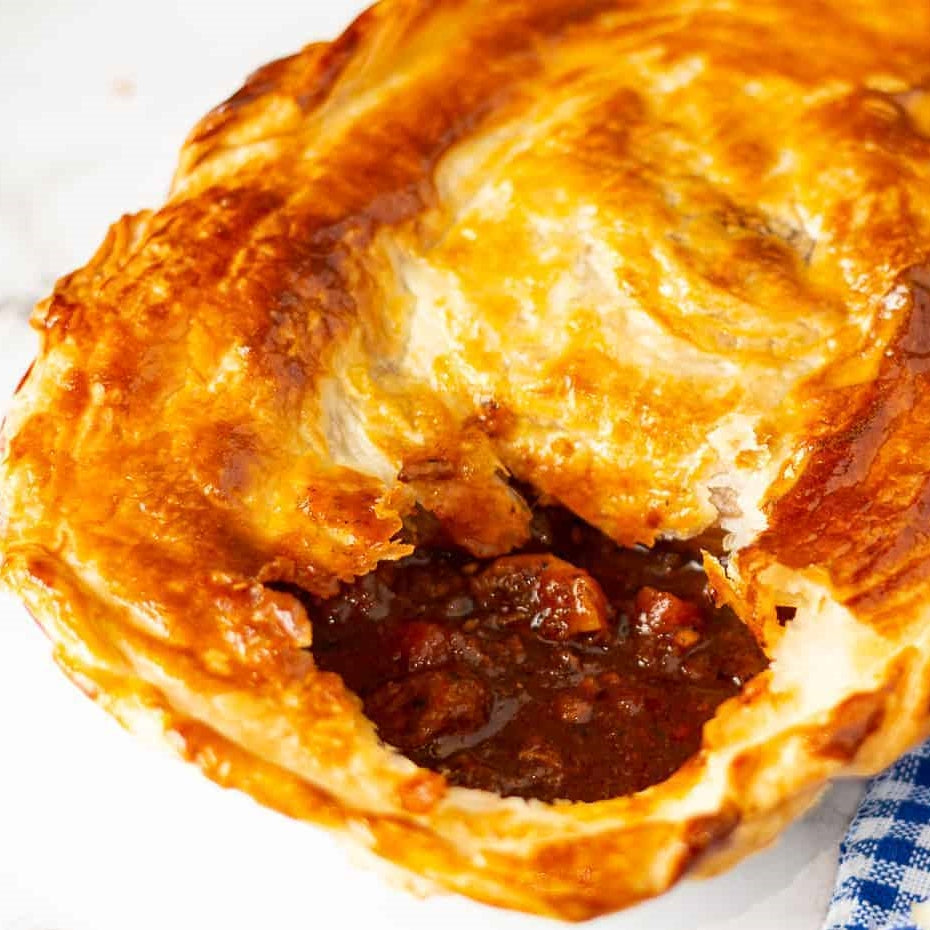Beef & Mushroom Pies
Beef & Mushroom Pies
These are the best weekend comfort food for the family.
Ready in: 3 hours 10 minutes
Serves: 6
Complexity: easy
kcal: 777
Share

Ingredients
1 tbsp olive oil
40 g butter
1 kg gravy beef, cut in 2 cm pieces
750 g small pickling onions
400 g portobello mushrooms
250 g bacon rashers, chopped
2 garlic cloves, crushed
¼ cup flour
1 tbsp SIDS HOT WORCESTER SAUCE
2 cups Red Dry wine
2 cups beef stock
2 sprigs fresh rosemary
6 sprigs fresh thyme
1 bouquet garni
2 sheets (25x 25 cm) puff pastry, just thawed
1 egg, lightly whisked
6 sprigs fresh thyme, extra
SIDS SALT & PEPPER to taste
Directions
Preheat oven to 150°C.
Heat ½ the oil and 10 g of the butter in a flameproof casserole dish over high heat. Add ¼ of the beef and cook, stirring, for 3-4 minutes until brown. Transfer to a heatproof bowl. Repeat in 3 more batches, with the remaining beef and reheating the pan between batches.
Heat the remaining oil and 10 g of the remaining butter in the same pan. Add the onions and cook, stirring, for 5 minutes until golden. Transfer to the bowl with the beef. Add the mushrooms to pan and cook, stirring, for 5 minutes until tender. Add the bacon and garlic and cook, stirring, for 5 minutes until brown. Transfer to the bowl.
Melt the remaining butter in the pan until foaming. Add the flour and cook, stirring with a wooden spoon to dislodge any bits that have cooked onto the base, until the mixture bubbles. Return the beef mixture to the pan. Add SIDS HOT WORCESTER SAUCE, wine, stock and cook, stirring, for 1 minute until combined. Bring to the boil. Remove from heat. Stir in the rosemary, thyme and bouquet garni. Season with SIDS SALT & PEPPER. Bake in oven, covered & stirring occasionally, for 2 hours until the beef is tender and the sauce thickens slightly. Set aside for 30 minutes to cool.
Increase oven to 200°C.
Spoon the beef mixture among six 375 ml (1½ cup) capacity ovenproof dishes. Use a 10 cm-round pastry cutter to cut three discs from each pastry sheet. Brush the top edge of one of the dishes with a little of the egg. Top with a pastry disc and press the edges to seal. Repeat with the remaining egg and pastry discs. Brush pies with any remaining egg and decorate with leftover pastry. Place pies on a baking tray. Bake for 20 minutes until pastry is golden and puffed.
Top the pies with the extra thyme sprigs and serve immediately.
HISTORY: The ingredients for the modern mince pie can be traced to the return of European crusaders from the Holy Land. Middle Eastern methods of cooking, which sometimes combined meats, fruits and spices, were popular at the time. Pies were created from such mixtures of sweet and savoury foods; in Tudor England, shrid pies (as they were known then) were formed from shredded meat, suet and dried fruit. The addition of spices such as cinnamon, cloves and nutmeg was, according to the English antiquary John Timbs, "in token of the offerings of the Eastern Magi. "Several authors, including Timbs, viewed the pie as being derived from an old Roman custom practised during Saturnalia, where Roman fathers in the Vatican were presented with sweetmeats. Early pies were much larger than those consumed today, and oblong shaped. The modern mince pie's precursor was known by several names. The antiquary John Brand claimed that in Elizabethan and Jacobean-era England they were known as minched pies, but other names include mutton pie, and starting in the following century, Christmas pie. Gervase Markham's 1615 recipe recommends taking "a leg of mutton", and cutting "the best of the flesh from the bone", before adding mutton suet, pepper, salt, cloves, mace, currants, raisins, prunes, dates and orange peel. He also suggested that beef or veal might be used in place of mutton. In the north of England, goose was used in the pie's filling, but more generally neats tongue was also used. A North American filling recipe published in 1854 includes chopped neat's tongue, beef suet, blood raIsins, currants, mace, cloves, nutmeg, brown sugar, apples, lemons, brandy and orange peel. During the English Civil War, along with the censure of other Catholic customs, they were banned: "Nay, the poor rosemary and bays, and Christmas pie, is made an abomination." Puritans were opposed to the Christmas pie, on account of its connection with Catholicism. In his History of the Rebellion, Marchamont Needham wrote "All Plums the Prophets Sons defy And Spice-broths are too hot; Treason's in a December-Pye, And Death within the Pot." Some considered them unfit to occupy the plate of a clergyman.

